数据库期中试题与答案
数据库期中测试答案
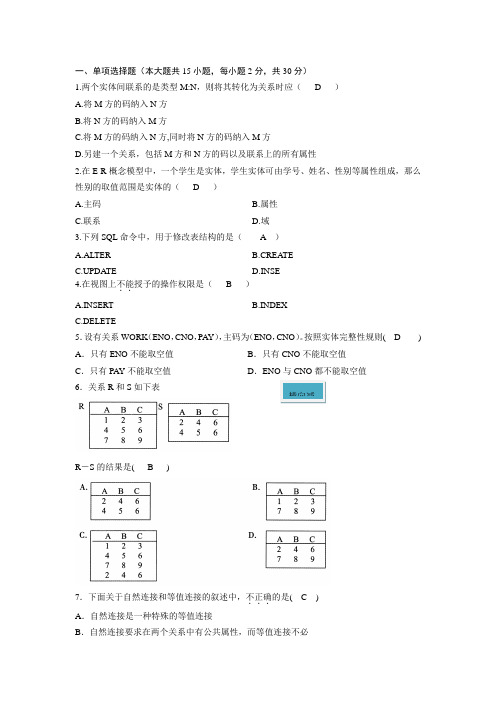
一、单项选择题(本大题共15小题,每小题2分,共30分)1.两个实体间联系的是类型M:N ,则将其转化为关系时应( D )A.将M 方的码纳入N 方B.将N 方的码纳入M 方C.将M 方的码纳入N 方,同时将N 方的码纳入M 方D.另建一个关系,包括M 方和N 方的码以及联系上的所有属性2.在E-R 概念模型中,一个学生是实体,学生实体可由学号、姓名、性别等属性组成,那么性别的取值范围是实体的( D )A.主码B.属性C.联系D.域3.下列SQL 命令中,用于修改表结构的是( A )A.ALTERB.CREATEC.UPDATED.INSE4.在视图上不能..授予的操作权限是( B )A.INSERTB.INDEXC.DELETE5.设有关系WORK (ENO ,CNO ,PAY ),主码为(ENO ,CNO )。
按照实体完整性规则(D ) A .只有ENO 不能取空值 B .只有CNO 不能取空值C .只有PAY 不能取空值D .ENO 与CNO 都不能取空值6.关系R 和S 如下表R -S 的结果是( B)7.下面关于自然连接和等值连接的叙述中,不正确...的是( C )A .自然连接是一种特殊的等值连接B .自然连接要求在两个关系中有公共属性,而等值连接不必C.两种连接都可以只用笛卡尔积和选择运算导出D.自然连接要在结果中去掉重复的属性,而等值连接不必8.设有关系表S(NO,NAME,AGE),其中AGE为年龄字段,则表达式AGE NOT BETWEEN 18 AND 24 等价于( D )A.AGE<=18 OR AGE>=24 B.AGE<=18 OR AGE>24C.AGE<18 OR AGE>=24 D.AGE<18 OR AGE>249.下列关于视图的说法中错误..的是( C )A.视图是从一个或多个基本表导出的表,它是虚表B.视图可以被用来对无权用户屏蔽数据C.视图一经定义就可以和基本表一样被查询和更新D.视图可以用来定义新的视图二、填空题(本大题共10小题,每小题1分,共10分)请在每小题的空格上填上正确答案。
数据库课程期中试卷答案
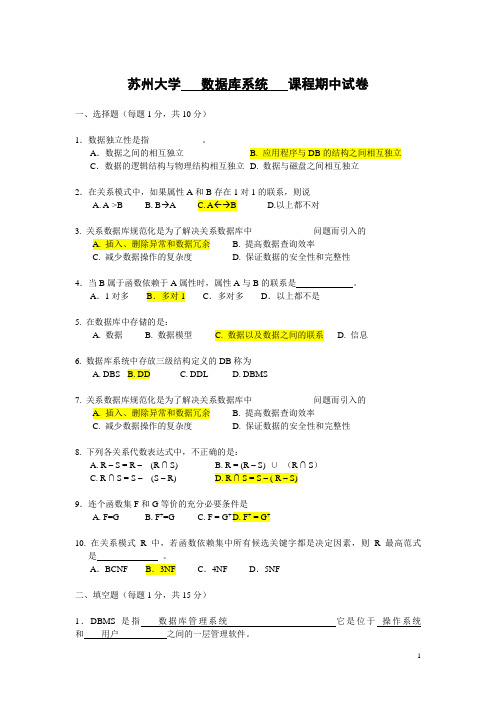
苏州大学数据库系统课程期中试卷一、选择题(每题1分,共10分)1.数据独立性是指___________ 。
A.数据之间的相互独立 B. 应用程序与DB的结构之间相互独立C.数据的逻辑结构与物理结构相互独立 D. 数据与磁盘之间相互独立2.在关系模式中,如果属性A和B存在1对1的联系,则说________A. A->BB. B→AC. A←→BD.以上都不对3. 关系数据库规范化是为了解决关系数据库中______________问题而引入的A. 插入、删除异常和数据冗余B. 提高数据查询效率C. 减少数据操作的复杂度D. 保证数据的安全性和完整性4.当B属于函数依赖于A属性时,属性A与B的联系是。
A.1对多B.多对1 C.多对多D.以上都不是5. 在数据库中存储的是:A. 数据B. 数据模型C. 数据以及数据之间的联系D. 信息6. 数据库系统中存放三级结构定义的DB称为A. DBSB. DDC. DDLD. DBMS7. 关系数据库规范化是为了解决关系数据库中______________问题而引入的A. 插入、删除异常和数据冗余B. 提高数据查询效率C. 减少数据操作的复杂度D. 保证数据的安全性和完整性8. 下列各关系代数表达式中,不正确的是:A. R – S = R –(R ∩ S)B. R = (R – S) ∪(R ∩ S)C. R ∩ S = S –(S – R)D. R ∩ S = S – ( R – S)9.连个函数集F和G等价的充分必要条件是A. F=GB. F+=GC. F = G+D. F+ = G+10. 在关系模式R中,若函数依赖集中所有候选关键字都是决定因素,则R最高范式C.4NF D.5NF二、填空题(每题1分,共15分)1.DBMS是指数据库管理系统它是位于操作系统和用户之间的一层管理软件。
2.关系数据库中,关系的完整性约束条件包括三大类__实体完整性___________、_____参照完整性___________和______用户定义的完整性_________________ 。
(附答案)数据库期中考试复习题目汇总
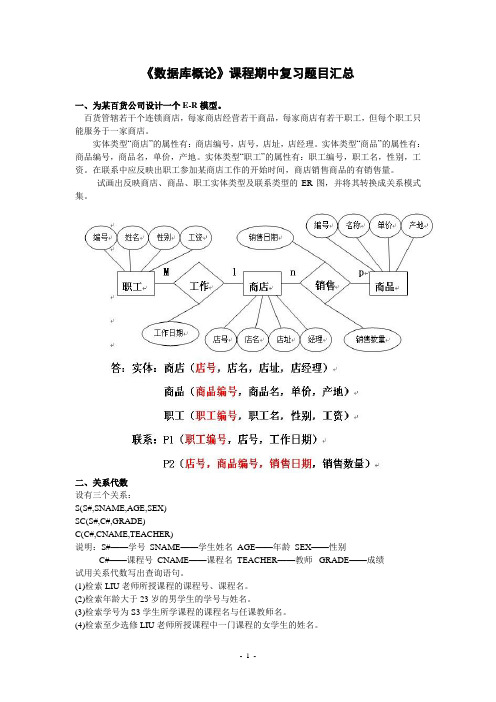
《数据库概论》课程期中复习题目汇总一、为某百货公司设计一个E-R模型。
百货管辖若干个连锁商店,每家商店经营若干商品,每家商店有若干职工,但每个职工只能服务于一家商店。
实体类型“商店”的属性有:商店编号,店号,店址,店经理。
实体类型“商品”的属性有:商品编号,商品名,单价,产地。
实体类型“职工”的属性有:职工编号,职工名,性别,工资。
在联系中应反映出职工参加某商店工作的开始时间,商店销售商品的有销售量。
试画出反映商店、商品、职工实体类型及联系类型的ER图,并将其转换成关系模式集。
二、关系代数设有三个关系:S(S#,SNAME,AGE,SEX)SC(S#,C#,GRADE)C(C#,CNAME,TEACHER)说明:S#——学号SNAME——学生姓名AGE——年龄SEX——性别C#——课程号CNAME——课程名TEACHER——教师GRADE——成绩试用关系代数写出查询语句。
(1)检索LIU老师所授课程的课程号、课程名。
(2)检索年龄大于23岁的男学生的学号与姓名。
(3)检索学号为S3学生所学课程的课程名与任课教师名。
(4)检索至少选修LIU老师所授课程中一门课程的女学生的姓名。
(5)检索W ANG同学不学的课程号。
(6)检索至少选修两门课程的学生学号。
(7)检索全部学生都选修的课程的课程号与学生学号。
(8)检索选修课程包含LIU老师所授课程的学生学号。
(用∞代表自然连接):(1)πC#,CNA ME(σTEA CHER='LIU'(C))(2)πS#,SNAME(σAGE>'23'∧SEX='男'(S))(3)πCNA ME,TEACHER(σS#='S3'(SC∞C))(4)πSNAME(σSEX='女'∧TEA CHER='LIU'(S∞SC∞C))(5)πC#(C)-πC#(σSNAME='WANG'(S∞SC))(6)πS#(σ1=4∧2≠5(SC×SC)) (SC自乘之后,同一个学号下两个课程号不同的元组)(7)πC#,S#(SC∞(πS#,C#(SC)÷πS#(S))))(8)πS#(σTEA CHER='LIU'(S∞SC∞C))三、SQL语句(1)1、建立一个数据库和五张表的表结构。
SQL数据库期中测试及答案
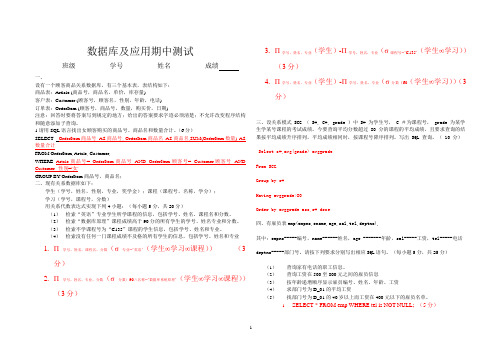
数据库及应用期中测试班级__________学号__________姓名__________成绩一、设有一个顾客商品关系数据库,有三个基本表,表结构如下:商品表:Article (商品号,商品名,单价,库存量)客户表:Customer (顾客号,顾客名,性别,年龄,电话)订单表:OrderItem (顾客号,商品号,数量,购买价,日期)注意:回答时要将答案写到规定的地方;给出的答案要求字迹必须清楚;不允许改变程序结构和随意添加子查询。
1.请用SQL语言找出女顾客购买的商品号、商品名和数量合计。
(6分)SELECT OrderItem.商品号AS商品号, OrderItem.商品名AS商品名,SUM(OrderItem.数量) AS 数量合计FROM OrderItem, Artcle, Customer,WHERE Artcle.商品号= OrderItem.商品号AND OrderItem.顾客号= Customer.顾客号AND Customer. 性别='女'GROUP BY OrderItem.商品号,商品名;二、现有关系数据库如下:学生(学号,姓名,性别,专业,奖学金);课程(课程号,名称,学分);学习(学号,课程号,分数)用关系代数表达式实现下列4小题:(每小题5分,共20分)(1)检索“英语”专业学生所学课程的信息,包括学号、姓名、课程名和分数。
(2)检索“数据库原理”课程成绩高于90分的所有学生的学号、姓名专业和分数。
(3)检索不学课程号为“C135”课程的学生信息,包括学号、姓名和专业。
(4)检索没有任何一门课程成绩不及格的所有学生的信息,包括学号、姓名和专业1.Π学号,姓名,课程名,分数(σ专业=‘英语’(学生∞学习∞课程))(3分)2.Π学号,姓名,专业,分数(σ分数)90∧名称=‘数据库系统原理’(学生∞学习∞课程))(3分)3.Π学号,姓名,专业(学生)-Π学号,姓名,专业(σ课程号=‘C135’(学生∞学习))(3分)4.Π学号,姓名,专业(学生)-Π学号,姓名,专业(σ分数《60(学生∞学习))(3分)三、设关系模式 SCG ( S#, C#, grade )中 S# 为学生号, C #为课程号, grade 为某学生学某号课程的考试成绩。
数据库期中试题及答案
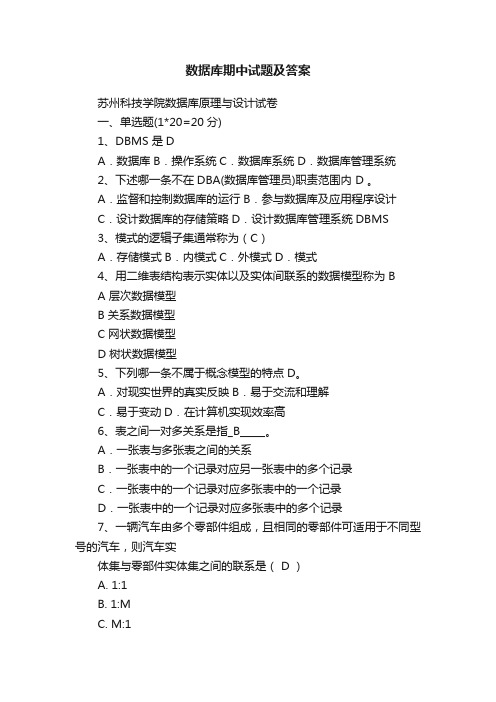
数据库期中试题及答案苏州科技学院数据库原理与设计试卷一、单选题(1*20=20分)1、DBMS 是DA.数据库B.操作系统C.数据库系统D.数据库管理系统2、下述哪一条不在DBA(数据库管理员)职责范围内 D 。
A.监督和控制数据库的运行B.参与数据库及应用程序设计C.设计数据库的存储策略D.设计数据库管理系统DBMS3、模式的逻辑子集通常称为(C)A.存储模式B.内模式C.外模式D.模式4、用二维表结构表示实体以及实体间联系的数据模型称为BA 层次数据模型B 关系数据模型C 网状数据模型D 树状数据模型5、下列哪一条不属于概念模型的特点D。
A.对现实世界的真实反映B.易于交流和理解C.易于变动D.在计算机实现效率高6、表之间一对多关系是指_B_____。
A.一张表与多张表之间的关系B.一张表中的一个记录对应另一张表中的多个记录C.一张表中的一个记录对应多张表中的一个记录D.一张表中的一个记录对应多张表中的多个记录7、一辆汽车由多个零部件组成,且相同的零部件可适用于不同型号的汽车,则汽车实体集与零部件实体集之间的联系是( D )A. 1:1B. 1:MC. M:1D. M:N8、设计数据库时首先应该设计 C 。
A.数据库应用系统结构B.DBMS结构C.数据库的概念结构D.数据库的控制结构9、概念设计的主要目标是产生数据库概念结构,该结构主要反映(D )A.DBA管理信息的需求B.数据库的维护需求C.应用程序开发的需求D.企业的信息需求10、设属性A是关系R的主属性,则属性A不能取空值,这是 AA.实体完整性规则B.参照完整性规则C.用户自定义完整性规则D.表完整性规则11、设关系R和S分别有m和n个元组,则R×S的元组个数是(D)A.m B.n C.m+n D.m×n12、下面不是SQL语言优点的是(D )A.语言简练,易学易用B.高度非过程化C.数据独立性好D.能方便地生成报表13、.取出关系中的某些列,并消去重复的元组的关系运算称为( B )。
2023-2024下《MySQL数据库技术及应用》期中试卷(带答案)

2023—2024下 2204班《MySQL数据库技术及应用》期中试卷一、单选题(2分*30=60分)1. select * from student 该代码中的* 号,表示的正确含义是( C )A. 普通的字符*号B. 错误信息C. 所有的字段名D. 模糊查询2. 数据库简称什么?( A )A.DBB.DBSC.DBMSD.DBA3. 数据库管理系统简称什么?( C )A.DBB.DBSC.DBMSD.DBA4. MySQL是哪种数据模型的数据库管理系统?( C )A.层次模型B.网状模型C.关系模型D.对象模型5. 下列描述正确的是( B )A. 一个数据库只包含一个数据表B. 一个数据库可以包含多个数据表C. 一个数据库只包含两个数据表D. 一个数据表可以包含多个数据库6. Mysql支持的数据类型,主要分成(C)类A. 1B. 2C. 3 D 47. 显示当前存在的数据库,正确的是(C)A. show databaseB. use databaseC. show databasesD. select database8. Create database mydb该代码的功能是(B)A. 创建表MYDBB. 创建数据库MYDBC. 修改数据库MYDBD. 删除数据库MYDB9. drop database MyDB001 该代码的功能是( B)A. 修改数据库名为MyDB001B. 删除数据库MyDB001C. 使用数据库MyDB001D. 创建数据库MyDB001 10. 下列(B)类型不是MySQL中常用的数据类型。
A.INT B. VAR C. TIME D. CHAR11. 36属于( C )A. 字符串型B. 浮点型C. 数字类型D. 日期和时间类型12. “abc”属于(A)A. 字符串型B. 整型C. 数字类型D. 日期和时间类型13. 删除字段正确的语句是(C)A. alter table ….. modify …….B. alter table ….. change …….C. alter table ….. drop …….D. alter table ….. add …….14. 查看数据库中数据表列表的命令是(B)A. show table;B. show tables;C. show databases;D. show database;15. 假设一个书店用(书名书号作者出版社出版日期库存数量……)一组属性来描述图书,可以作为“关键字”的是( A )A. 书号B. 书名C. 作者D. 出版社16. Sql语句中修改表结构的命令是(C)A. MODIFY TABLEB. MODIFY STRUCTUREC. ALTER TABLED. ALTER STRUCTURE17. 在create table 语句中,通常使用(D)关键字来指定主键。
数据库期中考试题及答案二
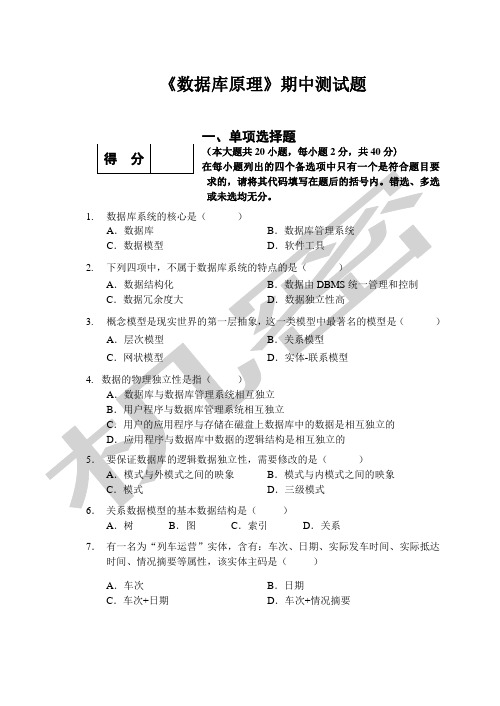
《数据库原理》期中测试题一、单项选择题(本大题共20小题,每小题2分,共40分) 得分在每小题列出的四个备选项中只有一个是符合题目要求的,请将其代码填写在题后的括号内。
错选、多选或未选均无分。
1. 数据库系统的核心是()A.数据库B.数据库管理系统C.数据模型D.软件工具2.下列四项中,不属于数据库系统的特点的是()A.数据结构化B.数据由DBMS统一管理和控制C.数据冗余度大D.数据独立性高3.概念模型是现实世界的第一层抽象,这一类模型中最著名的模型是()A.层次模型B.关系模型C.网状模型D.实体-联系模型4.数据的物理独立性是指()A.数据库与数据库管理系统相互独立B.用户程序与数据库管理系统相互独立C.用户的应用程序与存储在磁盘上数据库中的数据是相互独立的D.应用程序与数据库中数据的逻辑结构是相互独立的5.要保证数据库的逻辑数据独立性,需要修改的是()A.模式与外模式之间的映象B.模式与内模式之间的映象C.模式D.三级模式6.关系数据模型的基本数据结构是()A.树B.图C.索引D.关系7.有一名为“列车运营”实体,含有:车次、日期、实际发车时间、实际抵达时间、情况摘要等属性,该实体主码是()A.车次B.日期C.车次+日期D.车次+情况摘要8.己知关系R和S,R∩S等价于()A. (R-S)-SB. S-(S-R)C.(S-R)-RD. S-(R-S)9.用下面的T-SQL语句建立一个基本表:CREATE TABLE Student(Sno CHAR(4) PRIMARY KEY,Sname CHAR(8) NOT NULL,Sex CHAR(2),Age INT)可以插入到表中的元组是()A. '5021','刘祥',男,21B. NULL,'刘祥',NULL,21C. '5021',NULL,男,21D. '5021','刘祥',NULL,NULL10. 下列四项中,不属于数据库系统的主要特点的是()。
数据库期中考试试题含答案
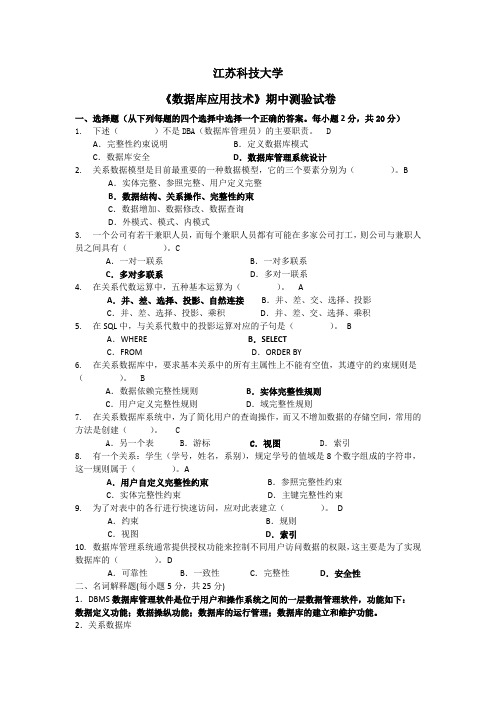
江苏科技大学《数据库应用技术》期中测验试卷一、选择题(从下列每题的四个选择中选择一个正确的答案。
每小题2分,共20分)1.下述()不是DBA(数据库管理员)的主要职责。
DA.完整性约束说明B.定义数据库模式C.数据库安全D.数据库管理系统设计2.关系数据模型是目前最重要的一种数据模型,它的三个要素分别为()。
BA.实体完整、参照完整、用户定义完整B.数据结构、关系操作、完整性约束C.数据增加、数据修改、数据查询D.外模式、模式、内模式3.一个公司有若干兼职人员,而每个兼职人员都有可能在多家公司打工,则公司与兼职人员之间具有()。
CA.一对一联系B.一对多联系C.多对多联系D.多对一联系4.在关系代数运算中,五种基本运算为()。
AA.并、差、选择、投影、自然连接B.并、差、交、选择、投影C.并、差、选择、投影、乘积D.并、差、交、选择、乘积5.在SQL中,与关系代数中的投影运算对应的子句是()。
BA.WHERE B.SELECTC.FROM D.ORDER BY6.在关系数据库中,要求基本关系中的所有主属性上不能有空值,其遵守的约束规则是()。
BA.数据依赖完整性规则B.实体完整性规则C.用户定义完整性规则D.域完整性规则7.在关系数据库系统中,为了简化用户的查询操作,而又不增加数据的存储空间,常用的方法是创建()。
CA.另一个表B.游标C.视图D.索引8.有一个关系:学生(学号,姓名,系别),规定学号的值域是8个数字组成的字符串,这一规则属于()。
AA.用户自定义完整性约束B.参照完整性约束C.实体完整性约束D.主键完整性约束9.为了对表中的各行进行快速访问,应对此表建立()。
DA.约束B.规则C.视图D.索引10.数据库管理系统通常提供授权功能来控制不同用户访问数据的权限,这主要是为了实现数据库的()。
DA.可靠性B.一致性C.完整性D.安全性二、名词解释题(每小题5分,共25分)1.DBMS数据库管理软件是位于用户和操作系统之间的一层数据管理软件,功能如下:数据定义功能;数据操纵功能;数据库的运行管理;数据库的建立和维护功能。
数据库期中测试1含答案
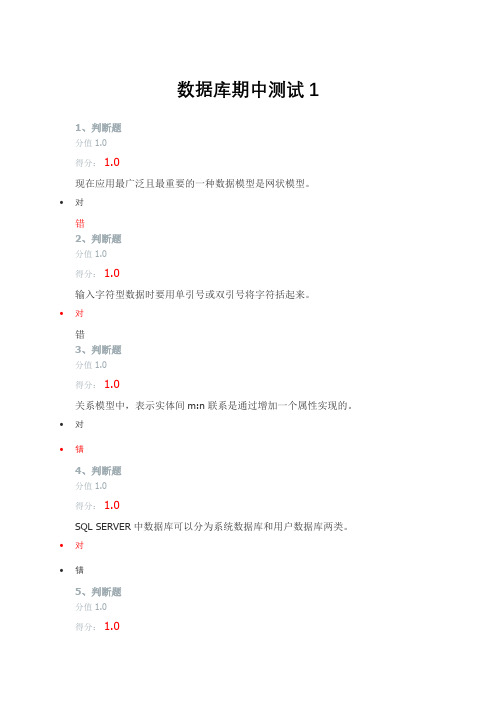
数据库期中测试11、判断题分值1.0得分:1.0现在应用最广泛且最重要的一种数据模型是网状模型。
•对错2、判断题分值1.0得分:1.0输入字符型数据时要用单引号或双引号将字符括起来。
•对错3、判断题分值1.0得分:1.0关系模型中,表示实体间m:n联系是通过增加一个属性实现的。
•对•错4、判断题分值1.0得分:1.0SQL SERVER中数据库可以分为系统数据库和用户数据库两类。
•对•错5、判断题分值1.0得分:1.0索引是对数据库表中一个或多个字段的值进行排序而创建的一种顺序存储结构。
•对•错6、判断题分值1.0得分:1.0SQL查询语句中,where子句中的条件可以使用聚合函数(count、max等)实现。
•对•错7、判断题分值1.0得分:1.0视图可基于多表建立。
•对•错8、判断题分值1.0得分:1.0IDENTITY(0,1)属性中,0为标识种子,1为标识增量。
•对•错9、判断题分值1.0得分:1.0一个数据表中,唯一索引只能建一个,聚集索引也只能建一个。
•对•错10、判断题分值1.0得分:1.0一个数据库的日志文件可以有多个,使用文件组对其进行管理。
•对•错11、单选题分值2.0得分:2.0有一个"列车运营"关系,含有:车次、日期、实际发车时间、实际抵达时间、情况摘要等属性,该关系的主键是()。
•A、日期•B、车次•C、(车次,日期)•D、(车次,情况摘要)12、单选题分值2.0得分:2.0数据库物理存储方式的描述称为()。
•A、外模式•B、•内模式•C、概念模式•D、逻辑模式13、单选题分值2.0得分:2.0SQL Server的物理存储主要包括两类文件,它们是()。
•A、图片文件和文本文件•B、•数据文件和事务日志文件•C、函数文件和数据文件•D、源文件和可执行文件14、单选题分值2.0得分:2.0在数据库中存储的是()。
•A、数据•B、数据模型•C、信息•D、•数据以及数据之间的联系15、单选题分值2.0得分:2.0视图提高了数据库的()。
数据库期中试卷及参考答案
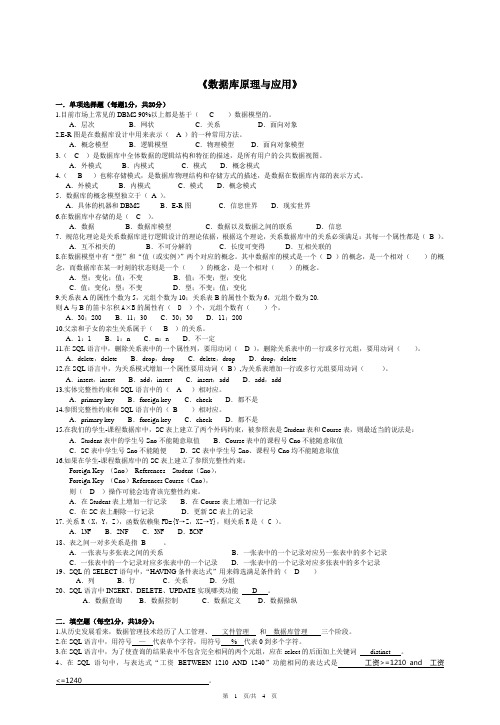
《数据库原理与应用》一.单项选择题(每题1分,共20分)1.目前市场上常见的DBMS 90%以上都是基于( C )数据模型的。
A.层次B.网状C.关系D.面向对象2.E-R图是在数据库设计中用来表示( A )的一种常用方法。
A.概念模型B.逻辑模型C.物理模型D.面向对象模型3.( C )是数据库中全体数据的逻辑结构和特征的描述,是所有用户的公共数据视图。
A.外模式B.内模式C.模式D.概念模式4.( B )也称存储模式,是数据库物理结构和存储方式的描述,是数据在数据库内部的表示方式。
A.外模式B.内模式C.模式D.概念模式5.数据库的概念模型独立于(A )。
A.具体的机器和DBMS B.E-R图C.信息世界D.现实世界6.在数据库中存储的是( C )。
A.数据B.数据库模型C.数据以及数据之间的联系D.信息7.规范化理论是关系数据库进行逻辑设计的理论依据,根据这个理论,关系数据库中的关系必须满足:其每一个属性都是(B )。
A.互不相关的B.不可分解的C.长度可变得D.互相关联的8.在数据模型中有“型”和“值(或实例)”两个对应的概念。
其中数据库的模式是一个(D )的概念,是一个相对()的概念,而数据库在某一时刻的状态则是一个()的概念,是一个相对()的概念。
A.型;变化;值;不变B.值;不变;型;变化C.值;变化;型;不变D.型;不变;值;变化9.关系表A的属性个数为5,元组个数为10;关系表B的属性个数为6,元组个数为20.则A与B的笛卡尔积A×B的属性有( D )个,元组个数有()个。
A.30;200B.11;30 C.30;30D.11;20010.父亲和子女的亲生关系属于( B )的关系。
A.1:1B.1:n C.m:n D.不一定11.在SQL语言中,删除关系表中的一个属性列,要用动词( D ),删除关系表中的一行或多行元组,要用动词()。
A.delete,delete B.drop,drop C.delete,drop D.drop,delete12.在SQL语言中,为关系模式增加一个属性要用动词(B),为关系表增加一行或多行元组要用动词()。
数据库原理与应用期中试卷答案
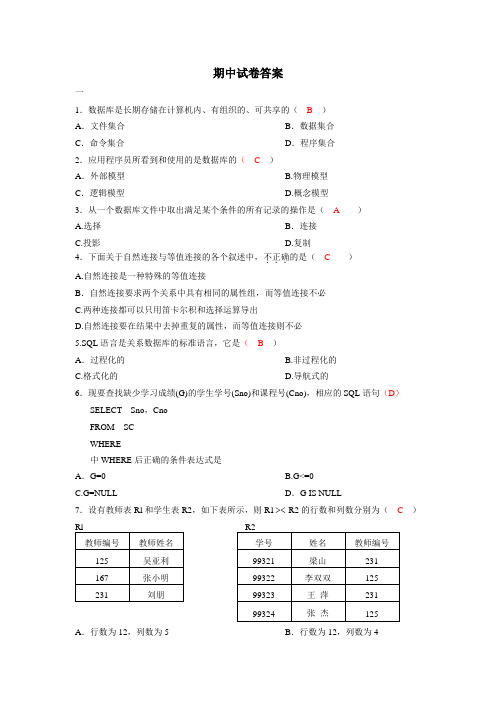
期中试卷答案一1.数据库是长期存储在计算机内、有组织的、可共享的(B)A.文件集合B.数据集合C.命令集合D.程序集合2.应用程序员所看到和使用的是数据库的(C)A.外部模型 B.物理模型C.逻辑模型 D.概念模型3.从一个数据库文件中取出满足某个条件的所有记录的操作是(A)A.选择B.连接C.投影D.复制4.下面关于自然连接与等值连接的各个叙述中,不正确...的是(C)A.自然连接是一种特殊的等值连接B.自然连接要求两个关系中具有相同的属性组,而等值连接不必C.两种连接都可以只用笛卡尔积和选择运算导出D.自然连接要在结果中去掉重复的属性,而等值连接则不必5.SQL语言是关系数据库的标准语言,它是(B)A.过程化的 B.非过程化的C.格式化的D.导航式的6.现要查找缺少学习成绩(G)的学生学号(Sno)和课程号(Cno),相应的SQL语句(D)SELECT Sno,CnoFROM SCWHERE中WHERE后正确的条件表达式是A.G=0 B.G<=0C.G=NULL D.G IS NULL7.设有教师表Rl和学生表R2,如下表所示,则R1 R2的行数和列数分别为(C)A.行数为12,列数为5 B.行数为12,列数为4C.行数为4,列数为4 D.行数为4,列数为58.SQL语言的一次查询的结果是一个(D)A.数据项B.记录C.元组D.表9.设有关系表R B)RA.a B.(a,b)C.(b,c) D.(a,c)10.在下面的数据库表中,若学生表的主码是学号,系别表的主码是系别号,用SQL语言不能..执行的下面操作是:(BD)学生表系别表A.从学生表中删除行(′005′,′王明′,20,′01′)B.将行(′005′,′王山′,19,′04′)插入到学生表中C.将学号为′001′的年龄改为18D.将学号为′010′的系别号改为′04′11. 规范化理论是关系数据库进行逻辑设计的理论依据,根据这个理论,关系数据库中的关系必须满足:每一个属性都是(B )。
数据库期中考试题
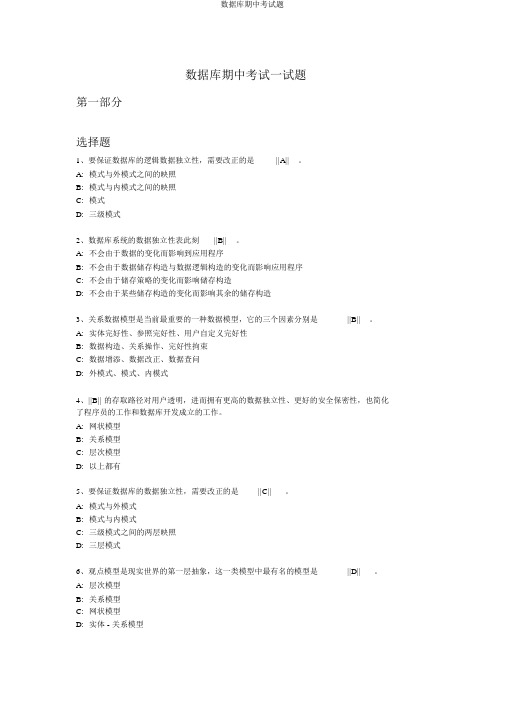
数据库期中考试一试题第一部分选择题1、要保证数据库的逻辑数据独立性,需要改正的是||A||。
A:模式与外模式之间的映照B:模式与内模式之间的映照C:模式D:三级模式2、数据库系统的数据独立性表此刻||B||。
A:不会由于数据的变化而影响到应用程序B:不会由于数据储存构造与数据逻辑构造的变化而影响应用程序C:不会由于储存策略的变化而影响储存构造D:不会由于某些储存构造的变化而影响其余的储存构造3、关系数据模型是当前最重要的一种数据模型,它的三个因素分别是||B||。
A:实体完好性、参照完好性、用户自定义完好性B:数据构造、关系操作、完好性拘束C:数据增添、数据改正、数据查问D:外模式、模式、内模式4、||B|| 的存取路径对用户透明,进而拥有更高的数据独立性、更好的安全保密性,也简化了程序员的工作和数据库开发成立的工作。
A:网状模型B:关系模型C:层次模型D:以上都有5、要保证数据库的数据独立性,需要改正的是||C||。
A:模式与外模式B:模式与内模式C:三级模式之间的两层映照D:三层模式6、观点模型是现实世界的第一层抽象,这一类模型中最有名的模型是||D||。
A:层次模型B:关系模型C:网状模型D:实体 - 关系模型7、下述 ||D||不是DBA数据库管理员的职责。
A:完好性拘束说明B:定义数据库模式C:数据库安全D:数据库管理系统设计8、下边列出的数据库管理技术发展的三个阶段中,没有特意的软件对数据进行管理的是||D|| 。
I .人工管理阶段II.文件系统阶段III.数据库阶段A:I 和IIB:只有 IIC:II 和 IIID:只有 I9、数据库( DB)、数据库系统(DBS)和数据库管理系统(DBMS)三者之间的关系是||A||。
A:DBS 包含 DB和 DBMSB:DBMS 包含 DB和 DBSC:DB 包含 DBS和 DBMSD:DBS 包含 DB,也就是 DBMS10、在数据管理技术的发展过程中,经历了人工管理阶段、文件系统阶段和数据库系统阶段。
2023级数据库期中考试(高一下)
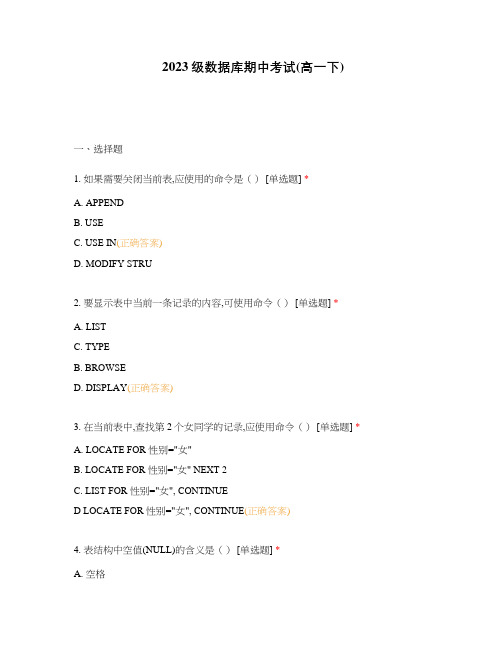
2023级数据库期中考试(高一下)一、选择题1. 如果需要关闭当前表,应使用的命令是() [单选题] *A. APPENDB. USEC. USE IN(正确答案)D. MODIFY STRU2. 要显示表中当前一条记录的内容,可使用命令() [单选题] *A. LISTC. TYPEB. BROWSED. DISPLAY(正确答案)3. 在当前表中,查找第2个女同学的记录,应使用命令() [单选题] *A. LOCATE FOR 性别="女"B. LOCATE FOR 性别="女" NEXT 2C. LIST FOR 性别="女", CONTINUED LOCATE FOR 性别="女", CONTINUE(正确答案)4. 表结构中空值(NULL)的含义是() [单选题] *A. 空格B.尚未确定(正确答案)C. 默认值D. 05. 自由表和数据库表的字段名可允许的最大字符数分别是()。
[单选题] *A. 128、128B. 10、128(正确答案)C. 10 、10D. 128、106. 如果一个表有备注型字段和通用型字段,那么它们的内容() [单选题] *A. 存储在不同的表备注文件中C. 都存储在同一表备注文件中(正确答案)B. 存储在同一文本文件中D. 存储在不同的文本文件中7. 顺序执行下列命令后,最后一条命令显示的结果是(假设XSB.dbf中有 20 条记录)()。
USE XSB,GO 10,SKIP 2,SKIP -6,?RECNO [单选题] *A. 5B. 6(正确答案)C. 7D. 88. 在当前数据表中,“婚否”字段为逻辑型字段,要显示所有未结婚的记录应使用命令错误的是()。
[单选题] *A. LIST FOR.NOT. 婚否C. LIST FOR 婚否<>.T.B. LIST FOR 婚否=.F.D. LIST FOR.NOT. "婚否"(正确答案)9. 若当前数据库表中有100条记录,当前记录号为10,执行命令 LIST NEXT 4 的结果是()。
数据库原理期中测试(带答案)

一、选择题.(题*分)、在图中,用来表示实体地图形是( ). 矩形框. 椭圆. 直线. 菱形资料个人收集整理,勿做商业用途、列值为空值(),则说明这一列:()、值为、值为空格、值是未知地、值是非法地、当使用语句往数据库表中插入一行数据时,在主键列值上如果出现重复值,那么会产生地情况是().资料个人收集整理,勿做商业用途、出错,操作失败、操作成功、操作成功,但要给出警告信息、自动把数据行地主键列值更改为没有重复地列值后在插入,操作成功.在建立一个数据库表时,如果规定某一列地缺省值为,则说明()、该列地数据不可更改、当插入数据行时,必须指定该列值为、当插入数据行时,如果没有指定该值,那么该列值为、当插入数据行时,无须显式指定该列值、地系统管理员地用户名为(). . . . 资料个人收集整理,勿做商业用途、在一个查询中,使用()关键字能够除去重复列值.、、、、、在子句中,如果没有指定(升序)或者(降序)地话,那么缺省地情况是()资料个人收集整理,勿做商业用途、、、或者中地任何一个、不进行排序、在关系数据库中,关系之间地联系是靠()处理地..连接字段值.表格.记录.属性、以下描述中不属于关系地性质地是:( ). 列是同质地,即每一列中地分量是同类型地数据,来自同一个值域. 行地顺序是无关紧要地,即行地次序可以任意交换. 列地顺序不可以任意交换. 每一个分量都必须是不可分地最小数据项、五种基本关系代数运算是(). ∪,,×,π和σ. ∪,,∞,π和σ. ∪,∩,×,π和σ. ∪,∩,∞,π和σ资料个人收集整理,勿做商业用途、当关系和自然联接时,能够把和原该舍弃地元组放到结果关系中地操作是(). 左外联接. 右外联接. 并操作. 外联接、中,下列涉及空值地操作,不正确地是().... ( )资料个人收集整理,勿做商业用途、关系代数表达式σ<()表示().表示从关系中挑选地值小于第个分量地元组.表示从关系中挑选第个分量值小于地元组.表示从关系中挑选第个分量值小于第个分量地元组.表示从关系中挑选第个分量值大于地元组、关系代数中地Π(投影)运算符对应语句中地以下哪个子句?()、下列语句中,能够实现“收回用户对学生表()中学号()地修改权”这一功能地是()资料个人收集整理,勿做商业用途()()()()二、简答题.、设有两个关系(,,) 和(,,),试用查询语句表达下列关系代数表达式π,(σ (∞)).(题*分)资料个人收集整理,勿做商业用途,,、现有如下图所示地关系数据库用语言实现下列)—)小题:(题*分)). 把对职工关系地查询权限给用户.职工)检索在广州地供应商信息* 供应商地址'广州')插入一个新地职工元组(,,)职工('',''))删除仓库号为""地仓库.仓库仓库号'')给低于所有职工平均工资地职工提高地工资职工工资工资*工资<( (工资) 职工))求所有职工地工资都多于地仓库地平均面积. (面积) 仓库仓库号( 仓库号职工工资<)。
《数据库原理与应用》期中阶段测试题
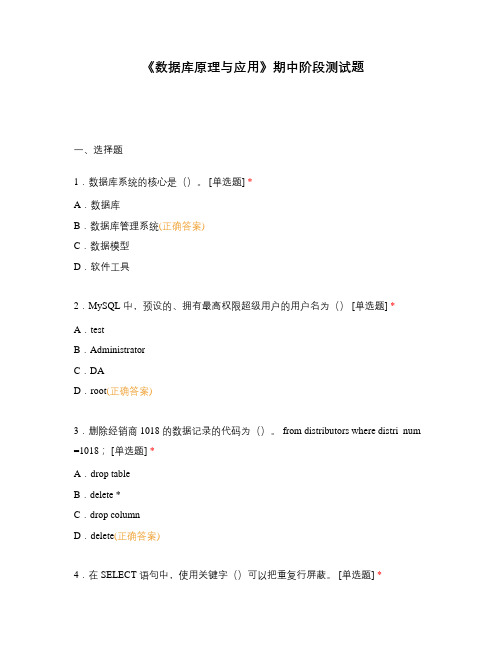
《数据库原理与应用》期中阶段测试题一、选择题1.数据库系统的核心是()。
[单选题] *A.数据库B.数据库管理系统(正确答案)C.数据模型D.软件工具2.MySQL 中,预设的、拥有最高权限超级用户的用户名为() [单选题] * A.testB.AdministratorC.DAD.root(正确答案)3.删除经销商 1018 的数据记录的代码为()。
from distributors where distri_num =1018; [单选题] *A.drop tableB.delete *C.drop columnD.delete(正确答案)4.在 SELECT 语句中,使用关键字()可以把重复行屏蔽。
[单选题] *A.TOPB.ALLC.UNIOND.DISTINCT(正确答案)5.以下聚合函数求平均数的是()。
[单选题] * A.COUNTB.MAXC.AVG(正确答案)D.SUM6.条件“IN(20,30,40)”表示()。
[单选题] *A.年龄在 20 到 40 之间B.年龄在 20 到 30 之间C.年龄是 20 或 30 或 40(正确答案)D.年龄在 30 到 40 之间7.按照班级进行分组()。
[单选题] *A.ORDER BY CLASSESB.DORDER CLASSESC.GROUP BY CLASSES(正确答案)D.GROUP CLASSES8.进入要操作的数据库 TEST 用以下哪一项()。
[单选题] * A.IN TESTB.SHOW TESTC.USER TESTD.USE TEST(正确答案)9.有关系 S(S#,SNAME,SAGE),C(C#,CNAME),SC(S#,C#,GRADE)。
其中 S#是学生号,SNAME 是学生姓名,SAGE 是学生年龄,C#是课程号,CNAME 是课程名称。
要查询选修“ACCESS”课的年龄不小于20 的全体学生姓名的SQL 语句是 SELECT SNAME FROM S,C,SC WHERE 子句。
数据库原理期中练习(答案)
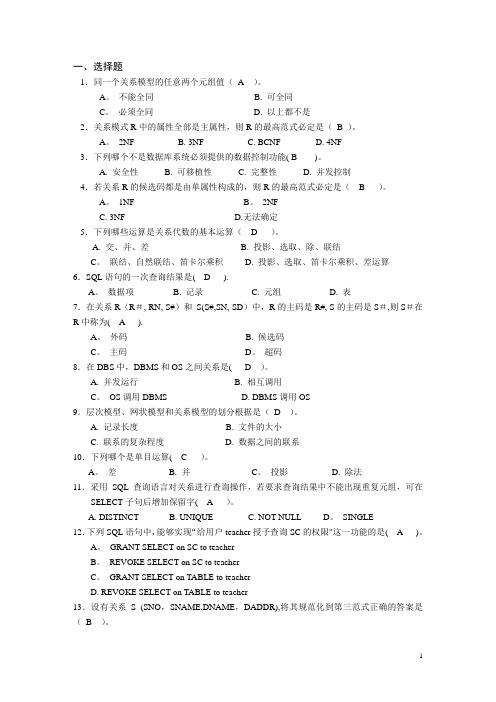
一、选择题1.同一个关系模型的任意两个元组值(A)。
A。
不能全同 B. 可全同C。
必须全同 D. 以上都不是2.关系模式R中的属性全部是主属性,则R的最高范式必定是(B )。
A。
2NF B. 3NF C. BCNF D. 4NF3.下列哪个不是数据库系统必须提供的数据控制功能( B)。
A. 安全性B. 可移植性C. 完整性D. 并发控制4.若关系R的候选码都是由单属性构成的,则R的最高范式必定是( B )。
A。
1NF B。
2NFC. 3NFD.无法确定5.下列哪些运算是关系代数的基本运算( D )。
A. 交、并、差B. 投影、选取、除、联结C。
联结、自然联结、笛卡尔乘积 D. 投影、选取、笛卡尔乘积、差运算6.SQL语句的一次查询结果是( D ).A。
数据项 B. 记录 C. 元组 D. 表7.在关系R(R#, RN, S#)和S(S#,SN, SD)中,R的主码是R#, S的主码是S#,则S#在R中称为( A ).A。
外码 B. 候选码C。
主码D。
超码8.在DBS中,DBMS和OS之间关系是( D)。
A. 并发运行B. 相互调用C。
OS调用DBMS D. DBMS调用OS9.层次模型、网状模型和关系模型的划分根据是(D)。
A. 记录长度B. 文件的大小C. 联系的复杂程度D. 数据之间的联系10.下列哪个是单目运算( C )。
A。
差 B. 并C。
投影 D. 除法11.采用SQL查询语言对关系进行查询操作,若要求查询结果中不能出现重复元组,可在SELECT子句后增加保留字( A )。
A. DISTINCTB. UNIQUEC. NOT NULL D。
SINGLE12.下列SQL语句中,能够实现“给用户teacher授予查询SC的权限"这一功能的是( A )。
A。
GRANT SELECT on SC to teacherB。
REVOKE SELECT on SC to teacherC。
数据库期中考试题及答案
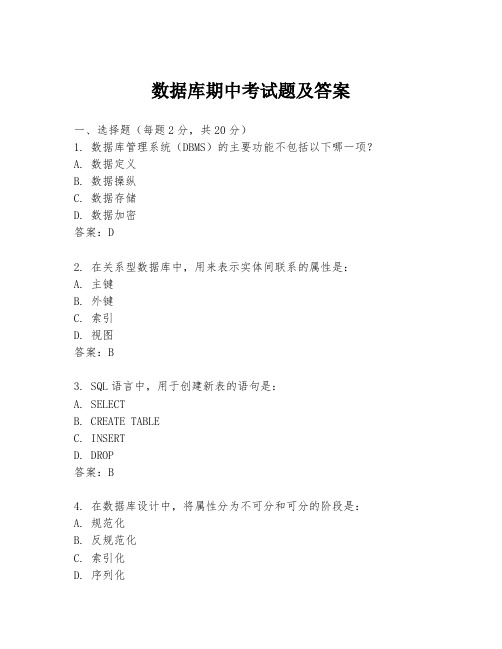
数据库期中考试题及答案一、选择题(每题2分,共20分)1. 数据库管理系统(DBMS)的主要功能不包括以下哪一项?A. 数据定义B. 数据操纵C. 数据存储D. 数据加密答案:D2. 在关系型数据库中,用来表示实体间联系的属性是:A. 主键B. 外键C. 索引D. 视图答案:B3. SQL语言中,用于创建新表的语句是:A. SELECTB. CREATE TABLEC. INSERTD. DROP答案:B4. 在数据库设计中,将属性分为不可分和可分的阶段是:A. 规范化B. 反规范化C. 索引化D. 序列化5. 数据库的完整性约束包括:A. 实体完整性B. 参照完整性C. 用户定义完整性D. 所有以上答案:D6. 以下哪个选项不是数据库的并发控制技术?A. 锁B. 事务日志C. 乐观并发控制D. 数据备份答案:D7. 在关系型数据库中,用于从一个或多个表中检索数据的查询语句是:A. UPDATEB. DELETEC. INSERTD. SELECT答案:D8. 数据库的三级模式结构包括:A. 内模式、概念模式、外模式B. 物理模式、逻辑模式、用户模式C. 内模式、外模式、用户模式D. 概念模式、逻辑模式、物理模式答案:D9. 在数据库中,用于定义数据存储结构的模式是:B. 外模式C. 概念模式D. 物理模式答案:D10. 数据库系统的核心是:A. 数据B. 数据库管理系统C. 数据库管理员D. 应用程序答案:B二、填空题(每题2分,共20分)1. 数据库系统由数据库、数据库管理系统、________、________和硬件组成。
答案:数据库管理员、应用程序2. 在关系型数据库中,一个表的________是用于唯一标识表中每行数据的。
答案:主键3. 数据库的________是用于防止数据丢失和错误的一种机制。
答案:事务4. 数据库的________是指在数据库中存储数据的物理结构。
答案:存储结构5. 数据库的________是指用户与数据库交互时所看到的数据库结构。
数据库期中考试参考答案
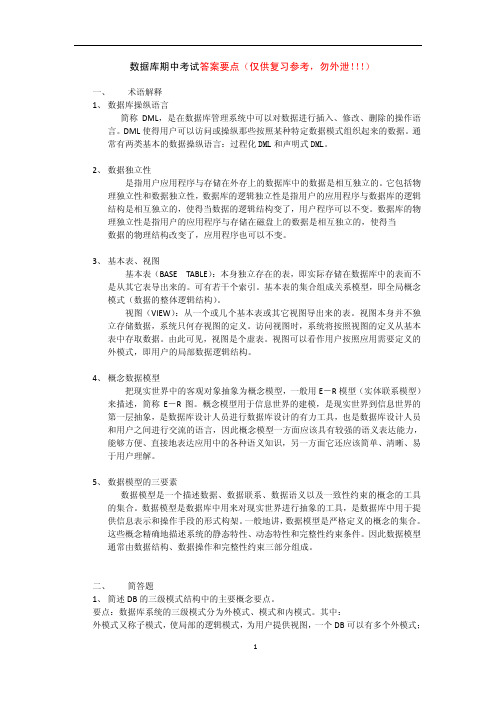
Where not exists ( (select CNO from Course_Selected as COURSE_SELCTED1, Student as STUD
where COURSE_SELCTED1.SNO=STUD.SNO and STUD.SNAME=’李明’) except (select SNO from Course_Selected as COURSE_SELCTED2,S where COURSE_SELCTED2.SNO=S.SNO)) )
D create view D as ( select SNAME from Student as S
where not exist (( select CNO from Course_Selected as COURSE_SELCTED1,Teacher as T where COURSE_SELCTED1.TNO=T.TNO and T.TNAME=’王芳’) except ( select CNO from Course_Selected as COURSE_SELCTED2 Where COURSE_SELCTED2.SNO=S.SNO))
<M>
航线
Variable characters (50)
工作日
Characters (50)
编号 <pi>
拥有
旅程段
旅程段编号 <pi> Integer
<M>
拥有
实际起飞港 实际到达港
Characters (50) Characters (50)
数据库期中复习题及部分答案
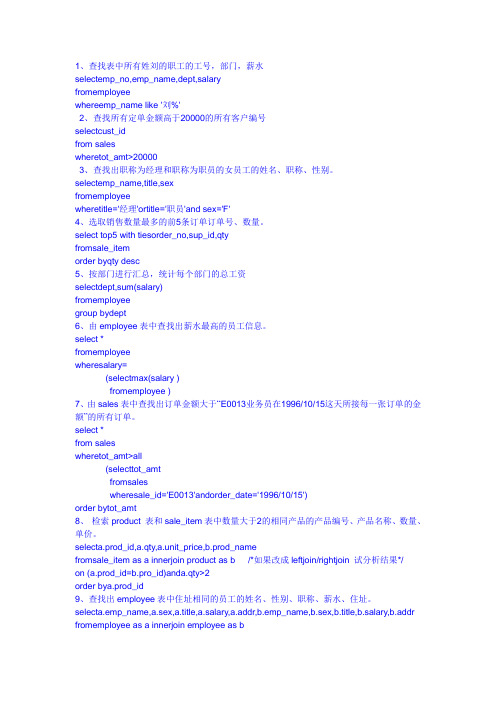
1、查找表中所有姓刘的职工的工号,部门,薪水selectemp_no,emp_name,dept,salaryfromemployeewhereemp_name like '刘%'2、查找所有定单金额高于20000的所有客户编号selectcust_idfrom saleswheretot_amt>200003、查找出职称为经理和职称为职员的女员工的姓名、职称、性别。
selectemp_name,title,sexfromemployeewheretitle='经理'ortitle='职员'and sex='F'4、选取销售数量最多的前5条订单订单号、数量。
select top5 with tiesorder_no,sup_id,qtyfromsale_itemorder byqty desc5、按部门进行汇总,统计每个部门的总工资selectdept,sum(salary)fromemployeegroup bydept6、由employee表中查找出薪水最高的员工信息。
select *fromemployeewheresalary=(selectmax(salary )fromemployee )7、由sales表中查找出订单金额大于“E0013业务员在1996/10/15这天所接每一张订单的金额”的所有订单。
select *from saleswheretot_amt>all(selecttot_amtfromsaleswheresale_id='E0013'andorder_date='1996/10/15')order bytot_amt8、检索product 表和sale_item表中数量大于2的相同产品的产品编号、产品名称、数量、单价。
selecta.prod_id,a.qty,a.unit_price,b.prod_namefromsale_item as a innerjoin product as b /*如果改成leftjoin/rightjoin 试分析结果*/on (a.prod_id=b.pro_id)anda.qty>2order bya.prod_id9、查找出employee表中住址相同的员工的姓名、性别、职称、薪水、住址。
- 1、下载文档前请自行甄别文档内容的完整性,平台不提供额外的编辑、内容补充、找答案等附加服务。
- 2、"仅部分预览"的文档,不可在线预览部分如存在完整性等问题,可反馈申请退款(可完整预览的文档不适用该条件!)。
- 3、如文档侵犯您的权益,请联系客服反馈,我们会尽快为您处理(人工客服工作时间:9:00-18:30)。
(2) Translate the ER diagram into a relational schema. (10 points) Artist (name:string, birthplace:string, age:integer, style:string) Artwork (title:string, year:string, type:string, price:real) Customer (cust_id:integer, name:string, address:string, amount:real) Group (name:string) Paints (title:string, name:string)
Suppose that you have set up a database company called “ArtBase” in order to build a product for art galleries. The core of this product is a database with a schema that captures all the information that galleries need to maintain. Galleries keep information about artists, their names (which are unique), birthplaces, age, and style of art. For each piece of artwork, the artist, the year it was made, its unique title, its type of art (e.g., painting, lithograph, sculpture, photograph), and its price must be stored. Note that each piece of artwork is painted by only one artist. Pieces of artwork are also classified into groups of various kinds (e.g., portraits, still lifes, works by Picasso, or works of the 19th century); a given piece of artwork may belong to more than one group. Each group is identified by a name (like those just given) that describes the group. Finally, galleries keep information about customers. For each customer, galleries keep that person’s unique id, name, address, total amount of dollars spent in the gallery (very important!), and the artists and groups of art that the customer tends to like. Note that each customer come to the galleries for the reason that they like at least one group of artworks. (1) Draw the ER diagram for the database. (10 points)
Pri nci pl es Of Da ta ba s e Sys tems - Mi dterm Exa m
中山大学软件学院 2011 级软件工程专业(2012 学年春季学期)
《 SE-304 数据库系统原理》期中试题答案
(考试形式: 闭 卷 考试时间:2 小时)
Problem 1 ER Diagram (20 points)
1
Pri nci pl es Of Da ta ba s e Sys tems - Mi dterm Exa m
Classify (title:string, name:string) Like_Group (cust_id:integer, name:string) Like_Artist (cust_id:integer, name:string) 注:Paints和Artwork可以合并成 Paint_Artwork (title:string, year:string, type:string, price:real, name:string)
3
Pri nci pl es Of Da ta ba s e Sys tems - Mi dterm Exa m
1NF。(因为R的码为AD,AB违反了部分依赖,所以R甚至不符合2NF。 所以它只符合1NF) BCNF分解过程: ① 违反函数依赖的有AB,DE,AC 按AB分解成AB,ACDEG ACDEG按DE分解成DE,ACDG ACDG按AC分解成AC,ADG 所以最后结果是AB, DE, AC,ADG (分解顺序不同也都是这个结果) ② 违反函数依赖的有AB,DE,BC 按BC分解成BC,ABDEG ABDEG按AB分解成AB,ADEG ADEG按DE分解成DE,ADG 所以最后结果是BC, AB, DE,ADG
2
Pri nci pl es Of Da ta ba s e Sys tems - Mi dterm ;内包含H。 C+ = CJI C+内一定包含C。因为CJ,所以C+内包含J。因为CJI,所以C+内包含I。 (2) Identify the candidate key(s) for R. Briefly explain the reason. (4 points) L = ABCD R = EFHI N=K LR = GJ 计算LN集合,即LN = ABCDK ,求出ABCDK +=ABCDEFGHIJK ,已经包含R 的全部属性。所以R的候选码为ABCDK 。 (3) Write down a minimal cover for the set F. Briefly explain the reason. (4 points) a. 将FD中的所有依赖右边化为单一元素 FD = {ABDE, ABG, BF, CJ, CJI, GH}已经满足。 b. 去掉FD中的所有依赖左边的冗余属性. 在依赖CJI中,因为C+=CJI,其中包含I,所以J是冗余的,可去除。 FD = {ABDE, ABG, BF, CJ, CI, GH} c. 去掉FD中所有冗余依赖关系. 做法为从FD中去掉某关系,如去掉XY,然后在FD中求X+,如果Y在X+中, 则表明X是多余的.需要去掉. 如果FD去掉ABDE, FD将等于{ ABG, BF, CI, GH },而 ABD+=ADBFGH,其中不包含E.所以ABD E不是多余的. 同理,ABG , BF , CI, GH不是多余,故不能去掉. 所以所求最小函数依赖集为{ ABDE, ABG, BF, CJ,CI, GH }.
Problem 2 Functional Dependencies and Keys (24 points)
1. Suppose you are given a relation R with four attributes ABCD. Assume that the following FDs are the only dependencies that hold for R. We have the FD set: F = {ABA, ABC, ABD, CA, DB} (1) Compute the attribute closure AB+ and A+ with respect to F with detailed explanation. (4 points) AB+ = ABCD AB+内一定包含AB。因为ABC,所以AB+内包含C。因为AB D,所以AB+内 包含D。 A+=A 因为从A无法推出其他属性。所以A+只包含A。 (2) Identify the candidate key(s) for R. Briefly explain the reason. (4 points) A+ = A, B+= B, C+=CA, D+=DB, AB+=ABCD, AC+=AC, AD+=ABCD, BC+=ABCD, BD+=BD, CD+=ABCD 所以R的候选码有AB,AD,BC,CD。 (3) Find out the trivial functional dependencies in F and prove that they are trivial FDs. (4 points) ABA 因为ABA 中,函数依赖右边的属性A是左边的属性 AB的子集,所以它是平 凡函数依赖。 2. Suppose you are given a relation R with attributes ABCDEFGHIJK. Assume that the following FDs are the only dependencies that hold for R. We have the FD set: FD = {ABDE, ABG, BF, CJ, CJI, GH} (1) Compute the attribute closure AB+ and C+ with respect to FD with detailed explanation. (4 points) AB+ = ABFGH AB+内一定包含AB。因为BF,所以AB+内包含F。因为AB G,所以AB+内包
